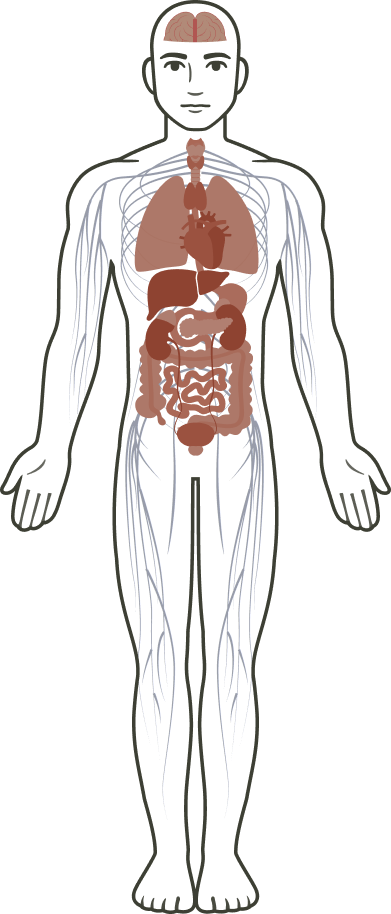
Patients with the classic phenotype have1,3:
Patients with late-onset phenotypes have1,3:
Symptoms in the late-onset phenotype usually are not identified until age 30 or later and may be limited to a single organ, usually the heart or kidneys (late-onset cardiac variant or late-onset renal variant).1 The first sign of Fabry disease may be heart disease or kidney failure.4
Some genetic variants in GLA, referred to as VUS, may be detected during screening but have an unclear relationship with clinical disease.3 Some individuals with these variants will have signs and symptoms consistent with Fabry disease, while others may be asymptomatic.5-8 Alpha-Gal A enzyme activity levels may be lower than in individuals without a GLA variant.9 In patients with VUS, clinical, biochemical, or histopathological evidence may be required to confirm Fabry disease.3,8 In addition, a family history of Fabry disease can predict pathogenicity for a GLA VUS.3,8 Consultation with a genetics professional is advised in cases of VUS.3
Females with Fabry were once referred to as “carriers,” but this is now known to be inappropriate.1 Fabry disease presentations and severity are especially variable in females, who may present with symptoms from mild to severe, with end organ damage similar to those in males with the classic phenotype.1 Females with Fabry disease are subject to cardiac, renal, and cerebrovascular complications of the disorder, and untreated females have a life expectancy 10 years fewer than those without Fabry disease.1
Lyonization, in which one copy of the X chromosome in each cell is randomly inactivated in females, contributes to this variability.1 Females may exhibit more or less severe symptoms if inactivation is skewed such that the wild-type or variant gene is inactivated more often.3,10
GLA, galactosidase alpha gene.
References: 1. Germain DP. Fabry disease. Orphanet J Rare Dis. 2010;5:30. 2. El-Abassi R, Singhal D, England JD. Fabry’s disease. J Neurol Sci. 2014;344(1-2):5-19. 3. Ortiz A, Germain DP, Desnick RJ, et al. Fabry disease revisited: management and treatment recommendations for adult patients. Mol Genet Metab. 2018;123(4):416-427. 4. Burban A, Pucylo S, Sikora A, Opolski G, Grabowski M, Kołodzińska A. Hypertrophic cardiomyopathy versus storage diseases with myocardial involvement. Int J Mol Sci. 2023;24(17):13239. 5. Viall S, Dennis A, Yang A. Newborn screening for Fabry disease in Oregon: approaching the iceberg of A143T and variants of uncertain significance. Am J Med Genet C Semin Med Genet. 2022;190(2):206-214. 6. du Moulin M, Koehn AF, Golsari A, et al. The mutation p.D313Y is associated with organ manifestation in Fabry disease. Clin Genet. 2017;92(5):528-533. 7. Sezer O, Ceylaner S. Genetic management algorithm in high-risk Fabry disease cases; especially in female indexes with mutations. Endocr Metab Immune Disord Drug Targets. 2021;21(2):324-337. 8. Zhou H, Wang S, Chen Y, et al. Fabry disease with genetic variants of unknown significance and concomitant immunoglobulin A nephropathy. Kidney Blood Press Res. 2024;49(1):799-811. 9. Klein A, Klug K, Breyer M, et al. Genetic variants of unknown significance in alpha-galactosidase A: cellular delineation from Fabry disease. J Inherit Metab Dis. 2024;47(4):805-817. 10. Echevarria L, Benistan K, Toussaint A, et al. X-chromosome inactivation in female patients with Fabry disease. Clin Genet. 2016;89(1):44-54. 11. Hoffmann B, Mayatepek E. Fabry disease—often seen, rarely diagnosed. Dtsch Arztebl Int. 2009;106(26):440-447.